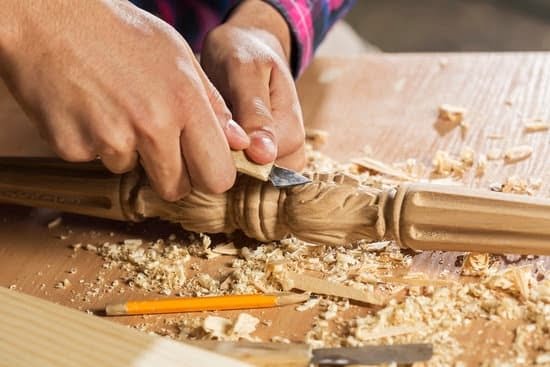A compressor is an essential tool in the field of woodworking, as it plays a crucial role in powering various pneumatic tools used for cutting, shaping, and finishing wood. Whether you are a professional woodworker or a hobbyist, understanding the size requirements of a compressor is vital to ensure optimal performance and efficiency in your projects.
In this article, we will explore the basics of compressors and their significance in woodworking, as well as provide valuable insights on how to choose the right size compressor for your specific needs.
Compressors are devices that convert power into potential energy stored in pressurized air. They work by drawing in air from the environment and compressing it into a smaller volume, resulting in increased pressure.
This compressed air can then be utilized to operate various pneumatic tools like nail guns, paint sprayers, sanders, and routers. The ability of a compressor to deliver sufficient airflow and maintain adequate pressure is crucial for ensuring smooth operation of these tools and the quality of your woodworking output.
When it comes to choosing the right size compressor for woodworking projects, several factors should be considered. One important factor is PSI (pounds per square inch), which measures the pressure at which air is delivered from the compressor.
Different woodworking tools have different PSI requirements, so selecting a compressor that can meet or exceed those requirements is essential for optimal performance. Additionally, assessing power requirements, considering tool compatibility, evaluating tank size for continuous operation, accounting for noise levels and portability needs, and factoring in budget constraints are all vital considerations when choosing the ideal compressor size.
In the following sections of this article, we will delve deeper into each aspect mentioned above and provide you with valuable information to guide you in selecting the appropriate-sized compressor for your woodworking projects. By understanding these factors and making an informed decision about compressor size, you can significantly enhance your woodworking efficiency while achieving professional-level results.
Understanding the basics of PSI
What is PSI?
PSI stands for pounds per square inch and it is a unit of measurement used to quantify the pressure exerted by compressed air. In woodworking, PSI is an important factor to consider when choosing a compressor, as it determines the power and effectiveness of your tools. Understanding how PSI affects your woodworking projects can help you make a more informed decision when selecting a compressor.
Power requirements for different woodworking tasks
Different woodworking tasks require varying levels of PSI to operate efficiently. For example, small finishing tasks such as sanding or painting may only require a lower PSI, while larger operations like using pneumatic nailers or spray guns may need higher pressure. It is important to assess the specific power requirements of each tool you plan to use in order to determine the ideal PSI range for your compressor.
The impact of PSI on woodworking performance
The level of PSI delivered by your compressor directly affects the efficiency and quality of your woodworking tasks. Insufficient pressure can result in weak airflow, leading to unsatisfactory results or even malfunctioning tools. On the other hand, too much pressure can damage delicate materials or cause unnecessary wear and tear on your tools. Finding the right balance of PSI is crucial for optimizing performance and achieving professional-level results in your woodworking projects.
Assessing the power requirements
When it comes to choosing the size compressor for your woodworking projects, one of the key factors to consider is the power requirements. The power requirements of a compressor are typically measured in horsepower (HP) and can vary depending on the specific needs of your woodworking tasks.
To determine the ideal size compressor for your woodworking needs, there are a few factors to keep in mind. First, consider the type and intensity of the woodworking projects you plan to undertake. Basic tasks such as sanding or stapling may require a smaller compressor with lower HP, while more demanding tasks like spraying or running multiple air tools simultaneously will require a larger compressor with higher HP.
Additionally, it’s important to consider the CFM (cubic feet per minute) rating of the compressor. CFM is a measure of how much air can be delivered by the compressor and is crucial for maintaining consistent pressure throughout your woodworking tasks. Different tools have different CFM requirements, so it’s important to match the CFM rating of your compressor with that of your tools.
To help you assess the power requirements and determine the ideal size compressor for your woodworking needs, here is a checklist:
- Make a list of all the air tools you currently use or plan to use in your woodworking projects.
- Determine the required CFM for each tool by consulting their specifications or manuals.
- Add up all these CFM ratings to get an estimate of how much air flow you need from your compressor.
- Consider any future expansions or upgrades that may require additional air flow.
- Match these requirements with compressors that offer sufficient HP and CFM ratings.
Once you have assessed the power requirements, you will be better equipped to choose a compressor that meets your woodworking needs efficiently and effectively without overloading or underperforming. Taking this step will ensure that you have optimal power supply for your tools and achieve professional results in your woodworking projects.
Matching the compressor to your tools
When it comes to choosing the right size compressor for your woodworking projects, it’s important to consider the specific tools you will be using and their air consumption. Different tools have varying air requirements, so matching the compressor to the tools is crucial for optimal performance.
One of the main factors to consider is the CFM (cubic feet per minute) rating of your tools. This measures the amount of air flow needed to keep them running properly. Some common woodworking tools and their CFM requirements include:
– Brad nailers: These typically require around 0.3 – 1.2 CFM at 90 PSI.
– Framing nailers: These tend to need higher CFM ratings, ranging from 2 – 7 CFM at 90 PSI.
– Sanders and grinders: These power-hungry tools often require higher CFMs as well, ranging from 8 – 12 or more.
Once you have identified the CFM requirements of your tools, it’s important to choose a compressor that can provide an adequate amount of air flow. You may need to add up the individual CFM ratings of multiple tools if you’ll be using them simultaneously.
In addition to considering CFM ratings, it’s also important to check the PSI (pounds per square inch) requirement of each tool. While most woodworking tools operate at around 90 PSI, there are exceptions such as spray guns which may require higher PSI levels. Make sure that the compressor you choose can deliver sufficient pressure for all your tools.
Matching the compressor to your specific woodworking tools ensures that they receive the proper amount of air flow and pressure, allowing them to work efficiently and produce high-quality results. Take the time to research and understand the air consumption requirements of your tools before making a decision on compressor size.
Evaluating tank size
Tank size is an important factor to consider when selecting a compressor for woodworking projects. The tank size directly affects the performance and air flow of the compressor, ultimately impacting the efficiency and quality of your woodworking tasks.
A larger tank size allows for more stored compressed air, which means that the compressor does not need to run as frequently to maintain a constant air supply. This leads to a more consistent air flow and reduces the strain on the compressor motor. With a larger tank, you can also handle bigger woodworking projects that require sustained air flow for longer periods of time.
On the other hand, a smaller tank size may be sufficient for smaller woodworking tasks or intermittent use. However, it can lead to more frequent cycling of the compressor and decreased performance if there is not enough stored compressed air to meet the demands of your tools.
It is important to assess your specific woodworking needs and consider the types of projects you will be working on when selecting a tank size. Consider factors such as the average running time of your tools, the required pressure and volume of air needed for each task, and whether you will be using multiple tools simultaneously. Evaluating these factors will help you determine an appropriate tank size that provides adequate performance and airflow for your specific woodworking needs.
| Tank Size | Benefits | Considerations |
|---|---|---|
| Small Tank | – More portable and easier to transport – Suitable for smaller woodworking tasks. – Lower initial cost | – May have limited capacity for sustained operation – Frequent cycling and potential loss in tool performance. – Not suitable for simultaneous use of multiple tools |
| Medium Tank | – Adequate capacity for most general woodworking tasks – Balanced performance and storage capacity. – Versatile for a range of projects | – May be heavier and less portable than smaller tanks – Higher initial cost compared to small tanks |
| Large Tank | – Ample air storage for sustained operation and larger projects – Consistent air flow with minimal cycling. – Suitable for simultaneous use of multiple tools | – Bulkier, heavier, and less portable – Highest initial cost compared to smaller tanks. – Requires more space for storage |
Noise levels and portability
Noise levels and portability are two important factors to consider when selecting a compressor for your woodworking projects. The noise level of a compressor can greatly impact the overall experience in your workspace, while portability determines the flexibility and mobility of your equipment. Finding the right balance between these two factors is crucial to creating a comfortable and efficient work environment.
When it comes to noise levels, it’s important to choose a compressor that operates at a decibel level that is tolerable for you and those around you. Woodworking can be a noisy process itself, so opting for a quieter compressor can help minimize distractions and create a more enjoyable working atmosphere. Additionally, if you plan on working late nights or in residential areas where noise restrictions may apply, choosing a low-noise compressor is essential.
Portability is another key consideration, especially if you need to transport your equipment frequently or work in different locations. A portable compressor allows for easy movement around your workshop or job site, enabling you to adapt to changing project requirements. Factors such as weight, size, and handle designs play an important role in determining the portability of a compressor. Lighter compressors with compact dimensions and ergonomic handles offer greater convenience during transportation.
| Compressor Size | Noise Level (decibels) | Portability |
|---|---|---|
| Small Compressor | 65-75 dB | Compact size and lightweight |
| Medium Compressor | 75-85 dB | Moderate weight and size |
| Large Compressor | 85+ dB | Heavier and bulkier |
By considering the noise levels and portability of different compressor sizes, you can find the right balance that suits your woodworking workspace and mobility needs. Whether you prioritize a quiet environment or require maximum portability, there is a compressor size available to meet your specific requirements.
The importance of airflow
One crucial factor to consider when choosing a compressor for woodworking projects is the importance of airflow. The airflow directly impacts the efficiency and quality of your tasks, making it a key consideration in selecting the right compressor.
Airflow refers to the amount of air that can flow through the compressor and be delivered to your woodworking tools. Insufficient airflow can lead to decreased performance and lower-quality results. When there isn’t enough air pressure, your tools may not function properly or deliver enough power for efficient cutting, shaping, or sanding.
On the other hand, having adequate airflow allows your tools to operate at their optimal level. This ensures smooth and precise cutting, consistent sanding results, and overall improved performance. With sufficient airflow, you can achieve professional-level craftsmanship in your woodworking projects.
To determine the necessary airflow for your woodworking tasks, you need to consider both the air consumption requirements of your tools and any additional accessories or attachments that will be used. Each tool typically has its own recommended PSI (pounds per square inch) and CFM (cubic feet per minute) ratings. These ratings indicate how much air pressure and volume are required for optimal operation.
By understanding these ratings for each tool and summing them up with any other accessories you plan to use simultaneously, you can assess the overall airflow requirements for your compressor. It’s important to choose a compressor that can provide sufficient airflow based on these calculations to ensure smooth operation across all your woodworking activities.
Budget considerations
Considering your woodworking requirements
When choosing the size compressor for your woodworking projects, it’s important to consider your specific requirements. Determine the type and scale of woodworking tasks you typically undertake. Are you a hobbyist working on small projects, or do you run a professional woodworking business that requires heavy-duty tools? Understanding your woodworking needs will help you determine the appropriate compressor size that can handle the demands of your projects.
Evaluating your financial constraints
While it’s crucial to choose a compressor that meets your woodworking requirements, it’s equally important to stay within your budget. Compressors come in a range of sizes and prices, so finding one that strikes a balance between affordability and performance is key. Consider how much you are willing to invest in a compressor and compare different models based on their features and cost.
Weighing the trade-offs
When navigating budget considerations for selecting the right size compressor, it’s essential to weigh the trade-offs between price and performance. While smaller compressors may be more affordable, they may lack the power necessary for larger woodworking tasks. On the other hand, larger compressors can provide ample power but may come at a higher price tag. It’s important to find a compromise that works best for you – balancing the cost with sufficient power to meet your woodworking needs.
By carefully considering both your woodworking requirements and financial constraints, you can find a compressor size that strikes the perfect balance. Assessing these factors will not only ensure that you have sufficient power for your projects but also help you make an informed decision when investing in a compressor for your woodworking endeavors.
Comparing different compressor sizes
When it comes to choosing the right size compressor for woodworking projects, it’s important to consider the different options available. In this section, we will provide a comprehensive analysis of small, medium, and large compressors to help you make an informed decision.
Small compressors are typically portable and compact, making them ideal for small woodworking projects or hobbyist use. They are often lightweight and easy to maneuver, making them a convenient choice for those who need mobility in their workspace. However, small compressors may not provide enough airflow or pressure for larger projects or heavy-duty tools. It’s important to assess your specific needs and ensure that a small compressor can meet them before making a purchase.
Medium-sized compressors strike a balance between portability and power. They often have larger tanks than their smaller counterparts, allowing for longer operation without needing to constantly refill the tank.
Medium compressors are generally suitable for both hobbyists and professionals who need more airflow and pressure for tasks such as sanding or using pneumatic nail guns. Consider the type of tools you will be using and their air consumption requirements when deciding if a medium compressor is the right choice for you.
Large compressors are designed with professional woodworking shops in mind. They offer high levels of airflow and pressure, making them suitable for heavy-duty tasks such as operating spray guns or running multiple tools simultaneously. Large compressors usually have substantial tank sizes that allow for extended operation without interruption. However, they can be louder than smaller models and may require dedicated space in your workshop due to their size and weight.
Ultimately, choosing the right size compressor depends on the scale of your woodworking projects and your specific needs. Consider factors such as portability requirements, the air consumption of your tools, available space in your workshop, as well as any budget constraints you may have. By evaluating these factors alongside our analysis of small, medium, and large compressors for woodworking, you can make an informed decision that will optimize your performance and achieve professional results.
Conclusion
In conclusion, choosing the right size compressor for your woodworking projects is crucial in order to optimize performance and achieve professional results. Throughout this article, we have discussed various factors that need to be considered when determining the ideal size compressor for your needs.
Firstly, understanding the basics of PSI and assessing the power requirements are essential steps in this process. By knowing the air pressure needs of your tools and the necessary power output, you can ensure that your compressor is capable of providing the required airflow for your woodworking tasks.
Matching the compressor to your tools is another important consideration. Different woodworking tools have varying air consumption rates, so it is vital to choose a compressor that can meet these demands. Evaluating tank size and considering noise levels and portability also play a role in finding the right balance for your workspace and mobility needs.
The importance of airflow cannot be underestimated when it comes to efficiency and quality in woodworking tasks. A properly sized compressor will provide consistent airflow, allowing you to work seamlessly and achieve professional results.
Lastly, budget considerations should not be overlooked. Finding a size compressor that balances your woodworking requirements with financial constraints is key. While larger compressors may offer more power and capacity, they can also come with a higher price tag. It is important to carefully evaluate your needs and prioritize accordingly.
By taking all these factors into account and comparing different compressor sizes, you can make an informed decision that will enhance your woodworking experience. Whether you opt for a small, medium, or large compressor, ensure that it meets all your necessary specifications for optimal performance and professional results in your woodworking projects.

Hi everyone! I’m a woodworker and blogger, and this is my woodworking blog. In my blog, I share tips and tricks for woodworkers of all skill levels, as well as project ideas that you can try yourself.





